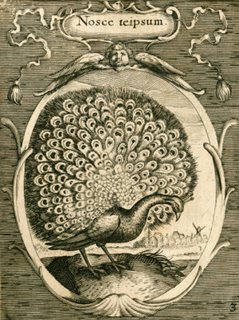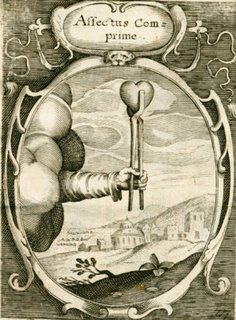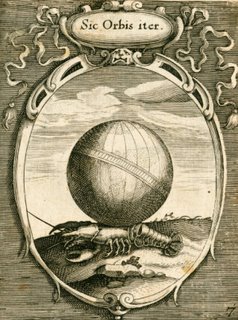"To the uninitiated, the emblem is indeed an esoteric artifact from the Early Modern Period. Its combinatory possibilites, however, associate it in many ways with the idea of the Renaissance individual - a person of many gifts and surprising talents whose charm consists of fresh new perspectives and engaging ideas. The emblem is very much the product of its age, combining texts and images in innovative ways for educational, devotional, entertainment, political and amorous purposes."

"The ideal emblem is typically described as a tripartite structure, comprised of motto (inscriptio), image (pictura), and epigram (subscriptio), and appeared in all European vernacular languages and latin. While emblems decorated secular and sacred architecture, objets d'art, and even everyday furniture and ephemeral art, such as triumphal arches for a monarch's entry, often emblems were published in books, and collections of emblems appearing in such volumes frequently, but not always, centred on a special theme or topos."



 "The sense of this arcane image and its texts is something like that proverbial saying 'two steps forward, one step backward'. The reader must know something about natural history and that crayfish scuttle backwards. Thus, the crayfish, with the globe on its back symbolizes the way of the world, or sic orbis iter. The epigram [not shown] deepens the message and relates it to a moral lesson, admonishing the reader to avoid the slippery slope of worldly things and to follow the divine path."
"The sense of this arcane image and its texts is something like that proverbial saying 'two steps forward, one step backward'. The reader must know something about natural history and that crayfish scuttle backwards. Thus, the crayfish, with the globe on its back symbolizes the way of the world, or sic orbis iter. The epigram [not shown] deepens the message and relates it to a moral lesson, admonishing the reader to avoid the slippery slope of worldly things and to follow the divine path."

German printer, draftsman and engraver, Peter Is(s)elburg (1658-1630) was a significant artist from the Cologne and Nuremburg areas. He had a wide area of subject matter from lampoons and portraits to cityscapes, religious images and costumery. His legacy also included a large portfolio of emblemata.
- The images here come from Emblemata Politica In Aula Magna Curiae Noribergensis Depicta: quae sacra virtutum suggerunt monita, prudenter administrandi, fortiterque defendendi Rempublicam published in 1617, hosted at this University of Illinois Urbana-Champaign site. [this link works as at December 2012]
- There are 32 engravings in total and after I finished uploading these examples I found that Isselburg's work is also online at Herzog August Bibliothek Wolfenbüttel and the best way to see all the emblems together in thumbnail format is via this Menemosyne intermediary website (clicking through each image takes you to the original jpeg file at HAB-W : and these are arguably a better/clearer product and they are also a bit larger).
- For anyone keen, the above quotes were snagged from "Digital Collections and the Management of Knowledge: Renaissance Emblem Literature as a Case Study for the Digitization of Rare Texts and Images" comprising a dozen seminar topics that were attended by all the major emblemata hosting sites in the world in 2003.
- Previous emblem entries here at BibliOdyssey.
- See also: i; ii; iii; iv; v; vi; vii; viii; ix; x at Giornale Nuovo.
No comments:
Post a Comment